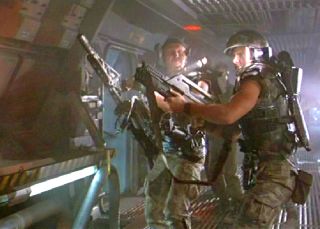 Last week I got a nagging feeling that I needed to catch up on some of the latest games I’d played and enjoyed Grand Theft Auto IV, as well as some other open-world and RPG titles, but occasionally there is a “huge” title that I just plain miss. This fall was a busy time… while I’d played Bioshock and some (but not enough) of Assassin’s Creed and Mass Effect, I’d completely breezed by Halo 3. As a long-time shooter fan/developer I figured I owed it to myself to put in a few hours and catch up with what’s held up as state-of-the-art.
Last week I got a nagging feeling that I needed to catch up on some of the latest games I’d played and enjoyed Grand Theft Auto IV, as well as some other open-world and RPG titles, but occasionally there is a “huge” title that I just plain miss. This fall was a busy time… while I’d played Bioshock and some (but not enough) of Assassin’s Creed and Mass Effect, I’d completely breezed by Halo 3. As a long-time shooter fan/developer I figured I owed it to myself to put in a few hours and catch up with what’s held up as state-of-the-art.
As I played through the first few levels, I got reminded of weird thing that always bothered me with the Halo series. The weapon you start with, the Assault Rifle, always starts the game on the wrong foot for me. It always felt anemic and ineffective against enemies, and the third installment wasn’t a whole lot better. I have no doubt that some of this might be a design choice, since it would be foolish to give the player a powerful weapon at the start of the game. Of course you need a lot of room for growth so that the player feels a sense of achievement as he/she finds new weaponry. However, for a weapon so obviously inspired by the Pulse Rifle from Aliens (one of the coolest movie guns ever), it’s always been tremendously disappointing to have my anticipation dashed… The gun looked and sounded so subdued and had little apparent effect on my opponents.
C’mon, watch this and tell me that you don’t want that rifle to be this badass sounding.
While I got past it and am now churning through Halo 3, the experience got me thinking about what elements make up a weapon that is satisfying to wield. Sure, making a weapon do more damage is what you’d expect, but there are a large number of intangibles that can add to the player’s shooter experience without disrupting the balance of the game.
Most of my roots are from Raven Software, where shooters are (mostly) a way of life. If there’s one thing that members of the studio preached constantly, most particularly my boss Brian Raffel, was that “the player must feel powerful”. It seems obvious, but a lot of times games don’t do enough to make the player feel like the gun in his/her hand is an unstoppable tool of destruction. This is about gratification and player expectation… Movies have trained audiences to expect that guns shoot massive plumes of flame and sparks and are accompanied by tremendous booming sound. In comparison, the sharp, loud crack or pop of a real gun can be a disappointment (although obviously they are intimidating nonetheless in person). Usually just modeling the audio and visual reality of a weapon isn’t quite enough.
Most games that have contemporary-style guns have a few standbys in their arsenal … the pistol, the machinegun or automatic rifle, and the shotgun. As an exercise, I cracked out a bunch of different first-person shooters and captured their weapons on video for the purposes of comparison. These games were:
- Halo 3 (Xbox 360, 2007)
- Resistance: Fall of Man (Playstation 3, 2006)
- Half Life 2 (PC, 2004)
- Quake 4 (PC, 2005)
- Doom (PC, 1993)
- Deus Ex (PC , 2000)
- Bioshock (Xbox 360, 2007)

In each, I took shots of the weapon firing at a surface, and follow with shooting at a “common” opponent. The choice of a “common” opponent is arbitrary (and sometimes driven by convenience when I was capturing footage), but suffice it to say that I wanted to choose an enemy that the player was going to face frequently with a given weapon. A few of these weapons also have “upgrades” that make them more effective, but I wanted to provide feedback on how the weapon would be seen upon first picking it up, will the player be glad he did? Will he or she keep using it because it’s just awesome?
The quality of some of the footage isn’t awesome because of some incredibly dark areas in some of these games, but you should get the idea. If I get a chance I’ll capture some cleaned-up versions of the footage and link ’em up. Each of the three weapon types has its own video sequence, and for each weapon, I examined several different elements that contribute to a sense of power:
- Gun Visuals: This refers to the visual effect of the weapon’s muzzle flash and bullet trail, and the animation of the weapon itself firing. It is the first thing people think of when they consider how the gun looks and feels.
- Sound Effects: Obviously this refers to the audio of the weapon, from the firing to the impact sounds, if appropriate. It can be tough to balance a sense of “power” in the sound without overdoing it, since the player may hear this same sound thousands of times… if it sounds like Zeus himself leveling mountains, you’ll quickly feel like you’re playing a cartoon.
- Effect on Environment: This includes the visual impact of the bullet on a wall or floor, as well as environmental shifts such as lighting. It is important because the results of stray bullets reinforce the player’s sense of having an impact on their environment and that they have a potent weapon.
- Effect on Opponent: A very important category, this refers to the visual impact on an enemy, and how the enemy reacts to being shot. This is critical to give the player feedback that he is successfully damaging the foe.
- Combat Effectiveness: This is a highly subjective category that is mostly driven by the overarching goals of the game’s arsenal, but worth mentioning. When a weapon is inaccurate or ineffective, it may be such because of an overabundance of ammunition for it, or perhaps the fact that it is designed for certain situations or opponents. It doesn’t change the fact that a wussy weapon can be irritating and simply avoided by frustrated players.
I’m not out to make a stink and necessarily rank these weapons (hey, I know some of the people who made these games) but there are certainly specific guns that do the job better than others. If I wanted to rate a weapon, I’d have to consider its effectiveness and how appropriately it fits into the game’s fiction, which means I’d have to take the entire arsenal into account (and be more fair to tech capabilities) instead of just looking at three weapons. Instead, I’ll talk about their choices and speak briefly about whether they aid or hamper a sense of power.
Pistols
Pistols are a mainstay of shooters because they are the most common type of firearm and most familiar to the audience. Since Wolfentein 3D it has been put in the hands of new players to give them a taste of gunplay, while still giving them plenty of room to grow into more formidable weaponry. Quake 2 started the short-lived trend of giving the pistol unlimited ammo so that the player does not have to fall back to melee attacks, but that was quickly eclipsed by the idea of the pistol being a low-powered precision weapon. Counterstrike in 1999 cemented the concept that a highly skilled player could be incredibly deadly if they could manage the head shots required to get a pistol kill.
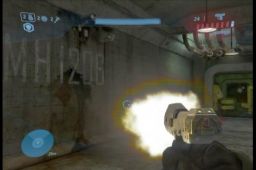 Halo 3
Halo 3
The Halo pistol is a fun one to start with because it is everything Halo’s Assault Rifle isn’t. The visual effects has a nice white-hot flame and a bit of smoke that covers a good chunk of the screen but disappears quickly. The audio is punchy but has a little throaty-ness to it. The effect on the environment is slight, with only a small spark on the walls however. When firing at an opponent, there isn’t a whole lot of feedback because there is little impact and they don’t always seem to hit react, unless you hit them in the head. In gameplay it has a steady rate of fire and reasonable stopping power that makes it fine for a skilled player.
Resistance: Fall of Man
Resistance’s arsenal had a lot of special-function weapons (being from the Ratchet and Clank folk), so they skipped the pistol in this game. Being a fan of every weapon having a “raison d‘etre“, I certainly don’t mind that they didn’t just throw in a pistol for extra quantity.
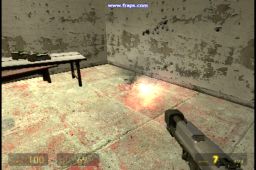 Half-Life 2
Half-Life 2
The Half-Life pistol is fairly unique in its semi-auto capability, which allows it to shoot as fast as you can hammer the trigger… making it extra-deadly in the hands of the skilled. The weapons in Half-Life tend to go a bit light on the pyrotechnics of the muzzle flash (which is more subtle and realistic), but the sharp crack and echo of the pistol audio makes it pretty dangerous-sounding. The environment impact effects are fairly small and smoky, but the bullet holes and tiny bouncing chunks coming off the wall add a nice sense of the physicality of the environment. When striking an opponent, the bloody impact is small unless there is a wall behind to show the blowthrough, but the nice part is the fact that humanoid enemies do twitch their body parts a bit upon impact, even if they are returning fire at the moment.
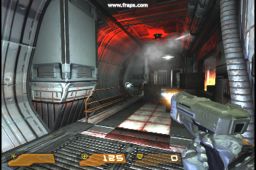 Quake 4
Quake 4
Considering it comes from my Alma Mater, I expected some meaty weapons from Quake 4 on par with the macho ones found in the Soldier of Fortune series… However, the pistol’s definitely a bit player in the game, doubtless because of the fact that it does not consume ammo. Its conical muzzle flash is subtle, and the bullet trail doesn’t add much to the gravity of your projectile. The “spacey” firing sound with an incredibly short envelope makes it seem more like air pistol, but again it’s probably on purpose to give more value to the weapons that aren’t “free”. The impact effects are nearly invisible, but at least the weapon has a nice light source when fired in a dark area. The impact on enemies is very slight as well, with only the occasional hit reaction until the enemy goes down.
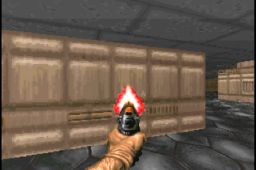 Doom
Doom
Perhaps it’s unfair to use a 15-year-old game in comparison with so many modern titles, but Doom accomplished so much for its time, and some of its fantastic gunfights have only rarely been matched in current games. The pistol from Doom is a bit timid these days, with its red-tinged hand-drawn muzzle flash and staccato “pow” sound effect… The impact effect on the walls is nice and visible, though the smoke rises too quickly taking the attention away from the point of impact. The slight “light” from the muzzle flash does well considering how old the tech is. The effect from striking the opponent is a nice red “flower” of blood, and the sprite enemies play jerky “hit” animation frames enough to get the point across so that you definitely feel like you’re hurting your foe. Finally, the pistol was a solid weapon for base enemies, taking them out in 3 or so shots, unlike pistols from many of the other games.
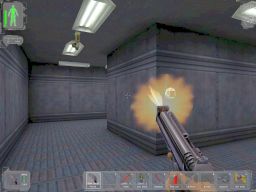 Deus Ex
Deus Ex
This game was not really known for its fast-action gameplay, but it provides an interesting comparison with other FPS weaponry. The muzzle flash is big, but it clearly was mostly a single flat polygon that doesn’t look white hot like its competitors do. The sound effect is certainly not timid, with a big “crashy” gunshot with a long, loud echo. The most disappointing part of this weapon is how little result you see on the environment, spouting only a tiny speck of wall from an impact. Enemies do not fare much better, with almost no effect appearing on a target when hit, and no hit reaction animation. Finally, since the game is extensively skill-based, the player’s accuracy with guns at the beginning of the game is ridiculously low, leading to many impotent-feeling shots.
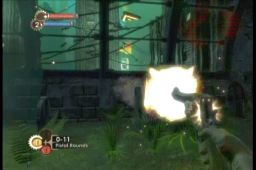 Bioshock
Bioshock
When I started this exercise, I almost forgot to include Bioshock, but I’m glad it made the list. Its pistol has a bright, large muzzle flash and cascading sparks, including from the hammer, as well as some nice lighting on the dark surroundings. The gunshot sound is a bit deeper than most of the others, but it has a fairly good echo after the initial crack. The surface impacts are the most impressive of this set, with lots of dust and sparks blooming from the point of impact, along with a chunk or two of the impacted surface. The impact on enemies is extremely rewarding, paying successful hits with glistening gouts of blood that nearly rival the excess and stylishness of Gears of War. Finally, the weapon’s fairly effective in combat and can be used as a staple weapon, as long as you can deal with the 6-shot reload cycle. The only unfortunately thing is animation of the weapon itself… Its placement onscreen evokes someone holding the weapon as far to the right of their head as possible, giving the overall firing and reloading actions a sort of weird “gangly” look. Compare this to most games that anchor the weapons about 1/3 from the bottom right corner.
Machineguns
I had to be a bit looser in my definition of “machineguns”, drawing from everything from heavy MG’s to submachine guns to assault rifles to miniguns. In general, these are the common weapons that people use to mow down opponents. It also goes all the way back to Wolfenstein 3D (with both the SMG and the gatling), and generally grants a nice sense of power from holding down the trigger to unleash hundreds of bullets. The application of this weapon varies from game to game, sometimes as a long-range spray weapon for very light enemies, to a closer-range “panic” weapon (see Aliens again) to being a precision implement for rewarding accuracy by putting many bullets in one enemy. For the purposes of this article I will mostly consider whether it feels freakin’ cool to use. (How’s that for scientific?)
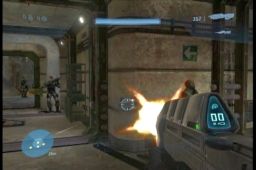 Halo 3
Halo 3
When I break down the Assault Rifle in Halo (which we’ve already discussed as “missing something” for me), I find the muzzle flash itself to be fairly fine. The weapon has a fairly large bulk that covers a chunk of the screen, so the bright, star-shaped muzzle flash does the job well. The muted firing sound is a disappointment however, evoking more of an electric typewriter than Hicks and Vasquez cutting loose. The environment impact effects are very small pockmarks and tiny sparks, although kudos to them for portraying bullets ricochet in random directions afterwards. The enemy impacts are nearly nonexistent, however. The opponents do have a satisfying animated hit reaction when struck, but rarely do I see where I hit them. In general, the Assault Rifle is more effective than it was in previous Halo installments, it still is almost useless unless you are fairly close to your opponent and tends to be skipped over when choosing a weapon loadout.
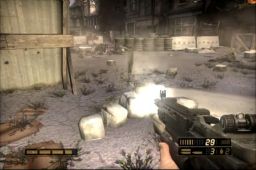 Resistance: Fall of Man
Resistance: Fall of Man
The M5A2 Carbine in Resistance is the player’s starting weapon, and definitely sees more use than the Halo rifle over the course of the game. This weapon has a nice, bright muzzle flash and a distinct screen shake when the weapon is fired. The sound effect is sharp with a nice echo and seems nicely realistic (in a “WWII movie” sort of way) to contrast with some of the more unusual weapons provided later on in the game. The environment impacts are certainly more prominent than Halo’s, with a high, vertical gout of dirt, although it’s pretty subtle when striking harder surfaces. When hitting an enemy, the dark sprays of blood provide okay feedback, although sometimes it’s hard to tell if you are significantly damaging one of the grunts. This can be a pain because the weapon seems volatile in its effectiveness. Sometimes a few shots do the trick and cut a hose on a foe, but sometimes they just won’t freakin’ die. Perhaps this is to cement the fact that the soldiers are vastly outgunned in this war, but there are too few weapons (and the Carbine shows up too often) to make this point at the cost of fun gameplay.
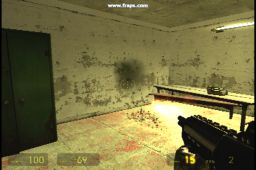 Half-Life 2
Half-Life 2
For an automatic weapon, the SMG from Half-Life 2 is a bit different than the others but it fits the bill because it is so frequently used. Once again, the weapon has a fairly subtle muzzle flash that isn’t the white hot light of a dozen suns, but it lets the firing rate and the vibration of the weapon do the talking. It unloads a ton of bullets, more than any other gun on this list, with a throaty chattering sound that blends individual shots into an intimidating roar. The impacts are once again dusty with little physics-driven wall “bits”, but the sheer quantity generated by the rate of fire of this weapon makes it fairly impressive and not too over-the-top. The blood spray from impacts is subtle again, although Valve made the blow-through extremely visible if the enemy is against a wall. The enemies don’t twitch too much when hit by this weapon, but this definitely feels like a precision weapon, so perhaps I don’t feel the need for as much validation of my hits. Overall it feels and plays like a deadly implement.
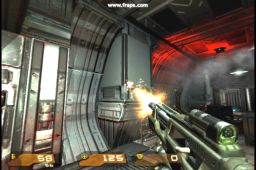 Quake 4
Quake 4
This weapon is a workhorse in Q4’s arsenal. Its firing effects aren’t too prominent, with the muzzle flash lasting only a frame or two, making individual shots more of a flicker or flash and making the weapon vibration and environment lighting carry the sense of power. The sound is extremely staccato, like the “realistic” Carbine in Resistance, but even more “nail-gun-like” because it is clearly made up of individual short gunshot sounds, unlike the Half-Life 2 SMG that blends them together. The impact effects are good, however, with large sparks cascading from the point of impact. Since the environment is mostly metal, the impact decals are fairly small and don’t leave a lot of evidence of the player’s action. Hitting an enemy spouts a misty spray of blood that is sometimes visible but can be missed, and as with many other games, the opponents don’t always hit react… This is generally for gameplay purposes so that the player does not excessive interrupt the enemy’s ability to fight back, but it definitely can lead to weaker feedback.
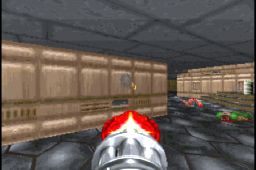 Doom
Doom
The minigun in Doom is the closest comparison to an automatic rifle for this category. The firing effects are fairly simple again with a hand-drawn flare and a slight environment lighting flicker. Otherwise, this weapon is basically a fast-firing pistol. Actually it literally is, using the same sound, impact, damage effects, and (if I recall correctly) the exact same projectile code as the pistol, so most of the pistol feedback applies. In terms of effectiveness, the weapon is all about peppering your enemies with dozens of pistol shots, making it effective at killing the masses of low-level enemies that is a staple of Doom gameplay. In addition, it carries a second role is locking down more beefy enemies like the Cacodemon, who gets caught in a “dance” of hit reaction animations while the player keeps firing.
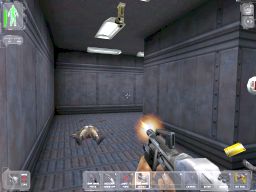 Deus Ex
Deus Ex
As with the pistol in Deus Ex, the muzzle flash for the assault rifle is a simple flat sprite that doesn’t have much motion and is slightly transparent, meaning that it doesn’t look “hot” enough. The firing sound effects are also fairly low-key, leading to less of a sense of power, which is surprising given the massive sounds generated from the pistol and shotgun. There is nearly no impact effect from using this weapon, on either the environment or an opponent… the enemies in particular do not hit react much at all from impacts. This is likely to avoid the “hit react dance” that lock down opponents in games like Doom, but the weapon is generally inaccurate enough at the start of the game that players can get frustrated after acquiring what they thought would be an awesome weapon. Early in the game, the best way to get kills is to fire up the body and go for the headshot.
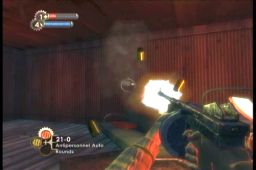 Bioshock
Bioshock
With the Thompson SMG, Bioshock once again delivers a nice sense of power in their weapon effects. The weapon’s muzzle flash is white-hot and the gun’s high rate-of-fire as well as the huge shells ejecting in all directions provides some very gratifying feedback. The sound is nice and staccato, but it also has a very long echo that helps blend the individual shots together, although a bit less than Half Life 2’s SMG. Each bullet’s impact on the environment is again very good, spouting an excessive amount of dust and sparks, and hits on enemies once again presents a prominent splash of blood that gives a tremendous sense of reward for being on target. Overall this weapon feels very good to wield.
Shotguns
The shotgun is an incredibly fun weapon to use in just about any game, being introduced so dramatically in Doom. Generally it’s a close-range weapon only, scoring almost certain kills within 5-10 feet, but reducing to near ineffectiveness once the enemy is very distant. Some games rely on the shotgun to be easy to use and allow the player to fire fairly quickly, but in general games limit their rate of fire with extensive recoil or reload times. However limited it is, the shotgun is nearly always one of the most satisfying weapons to use, from the sound to the effect it has on opponents. Few gamers don’t crack a smile when they find the very first shotgun in a new game.
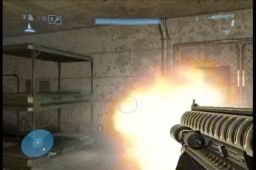 Halo 3
Halo 3
When it comes to ferocity, the Halo shotgun is a standout. Its huge muzzle flash covers almost a quarter of the screen with fire, sparks and smoke, and the sound is beefy with a very long echo trailing off. The impact effects are unfortunately very small, although there are enough pellets that it leaves a satisfying number of divots in the terrain afterwards. The impact on enemies is again fairly subtle, although the enemies will almost certainly play a hit reaction… if they survive the gunshot at all. If they do die, the enemies topple backwards with a nice sense of force. In the video, the brute shows off another nice bit of design. While they are tough enough that they can’t be flattened with a single shotgun blast, their armor generally gets knocked off with the first shot, giving the player a sense that he accomplished something rather than is continuously piling bullets into a relentless pile of meat.
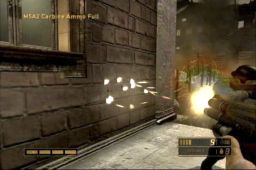 Resistance: Fall of Man
Resistance: Fall of Man
Compared with Halo, Resistance’s shotgun is a bit more subdued. Its muzzle flash is softer and less “hot” looking, and the weapon jerks back far enough that it appears to be firing towards the ceiling. Its sound effect is also a little hollower and lacks some of the “boom” of other shotguns. The world impacts are nice however, with the pellets causing many prominent sparks or sprays depending on the surface. The impacts on enemies, again, is mainly shown in their reactions, from hit animations to being thrown backwards as a corpse. It is another classic shotgun in that it is quite effective at taking enemies out in 1-2 hits, but in general it requires a very solid bead on the opponent to score an instant kill.
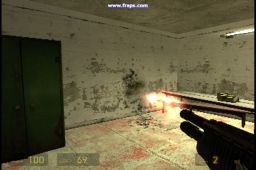 Half-Life 2
Half-Life 2
Living up to their precision credo in weaponry, the Half-Life shotgun is different in that its spray is much tighter than other game shotguns, perhaps being tuned for more realism or longer-range shootouts. In terms of visuals, the muzzle flash is 1-2 frames but is conical and meshes well with the nicely-animated weapon recoil. The sound effect is dramatic, but doesn’t rely on echo as much as other shotguns. The world impacts are once again dust and tiny bits, but come in a quantity that is satisfying in a “realistic” fashion. The impact on enemies again will come from the blood seen on the wall behind the enemy rather than the impact itself. In general, this weapon feels very satisfying without being overly “big”, with its tight shot spread making it deadly at a longer distance with only the six shot capacity as a weakness.
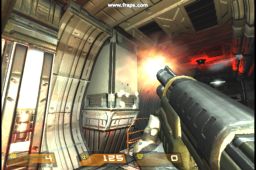 Quake 4
Quake 4
This shotgun has a softer muzzle flash that is a bit difficult to see, mainly because it is attached to the barrel of the gun after it recoils upwards. Since the fiery “action” is pulled towards the upper right of the player view, this shotgun’s impact effects provide most of the visual “punch” of this weapon. Unfortunately, the impact sparks are much less prominent than they were with Quake 4’s machinegun, perhaps due to performance reasons with the number of particles generated. The sound effect is a nice combination of “punchy” and “crunchy” without having to rely on a long echo… The impact on an enemy can be a mixed bag. The standard misty spray of blood is generated when a character is hit, but it doesn’t always animate in response. However, if the enemy is killed, it flies back very far (which can be quite satisfying). This weapon is a good member of the Q4 arsenal, except for its criminally long reload time.
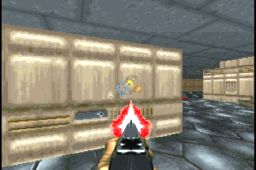 Doom
Doom
Every first person shooter owes the Doom shotgun a great debt… When it came out it was the coolest damn weapon players had ever wielded, unmatched for years for its raw sense of power as well the satisfying recoil-and-cock animation after the shot. The hand-drawn muzzle flash itself of course looks dated these days, but the cocking motion up and left still provides a nice perspective view of a weapon that otherwise is only seen from an extreme back angle. The sound is throaty and dangerous-sounding even now, and the environment impacts provide a fairly good cloud of dust. Best of all, when hitting a grunt enemy, from a soldier to an imp, Doom’s shotgun doesn’t disappoint. Most baseline foes perish in one hit, flying backwards in a bloody arc that still grants a satisfying experience.
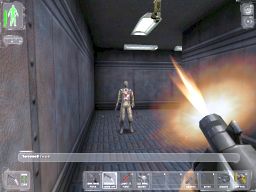 Deus Ex
Deus Ex
The sawed-off shotgun is one of two in Deus Ex, but I used it because it is more “typical” than the game’s semi-auto shotgun. The muzzle flash sprite, like the other Deus Ex weapons, was again very hard-edged with not enough brightness to make it look “hot” (likely due to using alpha instead of additive transparency for the sprite). Since the gun recoils far up and to the right, your eye focuses more on the impact of your shot, which is marked by only a few bits of wall flung about. Similarly, only a few tiny bits of blood are visible when striking an opponent although a hit reaction animation was nicely more common. This weapon has a “boomy” sound is as similarly overstated as the pistol, feeling a bit too cartoony to listen to over the course of an entire game. Finally, since I wanted to compare weapons at a skill level more suitable to first impressions, so once again Deus Ex’s skill system gave me a very low accuracy with this gun. For a weapon that I pick up and expect to be satisfying, this might have higher realism, but it felt the most impotent of the shotguns.
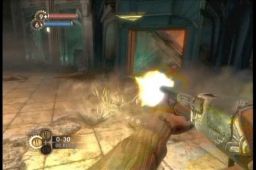 Bioshock
Bioshock
Nice to end on a high note… The Bioshock shotgun was truly a surprise to me when I filmed it, even though I had already played a fair amount of the game. The muzzle flash is large and is accompanied by a nice satisfying cocking animation that evokes Doom’s. Unfortunately the recoil brings the weapon far to the right like the pistol, which provides the awkward-looking arm positioning seen in the pistol as well. The firing sound effect has a nice “crack” with a long echo trailing off, but the best part are the world impacts, which stir up huge chunks of the ground, leaving dust, sparks, and huge divots. When striking an enemy, the big ol’ blood splash comes through for us again, giving us juicy feedback that we just hurt someone bad. Overall this is a good weapon that can take an enemy down in a couple of hits, and makes you feel good whether you hit or not… everything a shotgun should be.
More Power, Mister Scott!
To summarize, if you to give me that awesome feeling when I pick up a weapon in a shooter, these are the things I look for:
- A nice sized, white-hot muzzle flash effect, with a small amount of lingering smoke. Not so much as to obscure what I’m shooting at, though.
- Good localized world lighting eminating from my weapon.
- A recoil animation that pulls back significantly, but doesn’t pull back so far that the muzzle flash isn’t pointed at the target.
- A bit of screen shake for more powerful weapons.
- Sound effects with a sharp attack and a nice tail (“echo”). If the weapon is automatic, make the tail enough that they blend the various shots together into a “growl”.
- Wall impacts that impart a lot of dust (or sparks vs. metal) and loose nice, visible, unrealistic chunks of wall.
- Impact decals that are at least the size of a fist, and more specifically can be seen up to 10 feet.
- Enemy impacts marked with a significant splash of blood, a size that equals perhaps 1/3 of the body.
- Enemy hit reactions whenever possible, and always with a shotgun. If it is possible to give the enemy’s body a jerk without disrupting his ability to act (see Half Life 2), use that.
- An enemy that dies from a gunshot should not crumple straight to the ground, but be knocked back slightly from a pistol kill, and signficantly from a shotgun kill.
- An enemy’s death should be marked by a distinctive scream or other sound so that they know when the opponent is down, even if he continues to ragdol upright for a period of time.
- The more inaccuracy you impart on your gun, the more important the visibility of your hits need to be, so that the player doesn’t assume they are scoring hits when they are not. Regardless, avoid excessive inaccuracy in any gun to avoid frustration.
I hope this little tour has been informative in how different weapons can give that ol’ feeling of power. If I have time I may add new games with similar weapons for comparison. However, what might be more useful is undergoing the same exercise for third person weaponry… Compared to first-person, a third-person game has a much more difficult time conveying a sense of power because the action isn’t quite as “in-your-face”. As such, some games like Grand Theft Auto never really achieve the gratifying result of a gunshot that an FPS can. I’ve seen a few that do, but that will wait for another day.

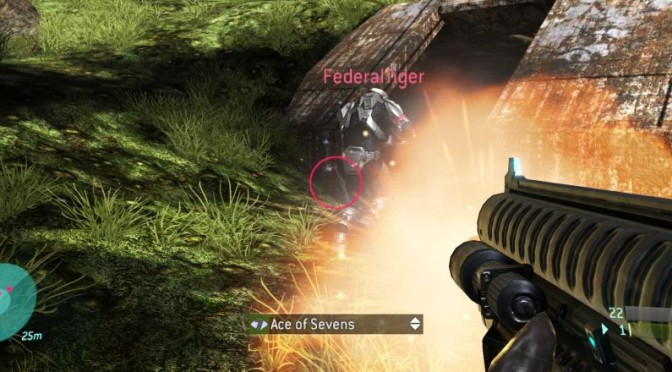
You’re obviously having some sort of problem with Deus ex, because those weapons, and the HUD do not look like that;
Case in point, the pistol:
http://image.com.com/gamespot/images/screenshots/gs/rpg/deusex/deusex_screen001.jpg
Thanks for the catch sir. The positioning of the gun seemed strange choice when I was writing the piece, but I just remembered being underwhelmed by the guns when I played and got specific by watching the video I had captured (I just checked and the guns are positioned properly). I guess Fraps was not kind to it… although Doom/Quake4/HL2 all capped fine. I edited the post to remove the gun-offscreen comments, although everything else still applies. I’ll get updated media as soon as it proves practical. I’ll try for a level that isn’t so damn dark. 😛
Fixed.
Excellent article and very helpful. I do think it curious though that you left out Counter-Strike Source and Call of Duty 4. Right now, I’d consider them leaders in this area. CS:S shotguns, in particular, are very satisfying with the power they deal up close.
They would be a great addition to an excellent article.
Thanks! If there is interest I’ll add more games and do an expanded version. As it was I just tried to pick a few recent and a few iconic games, or whatever came to mind. Plus capturing from an online game would be a pain. :-). If I wanted to look at more games with the holy trinity of weaponry, I’d have a bunch of possible sources: Counterstrike (which certainly influenced HL2’s weapon feel), Doom 3, FEAR, COD4, Soldier of Fortune.
While I’ve tuned weapons myself in the past, the act of going out and capturing this footage was a useful exercise in discovering what I consider to be a successful weapon experience. As I said, I also want compare this with where third person games have trouble succeeding. One of the few that did succeed started with a G, and it ain’t GTA.
GRAW?
I’d love to see your take on rocket launchers as well – and I wouldn’t mind seeing an overview of “extraodrindary weapons”, like the BFG or the Spartan Laser.
That’s a great idea. Every game as its special weapon that shines and makes you feel godlike, and on the flipside nothing drives me more crazy than getting to the “awesome blow shit up” weapon and feel like you’re shooting water baloons instead.
Re GRAW: Great idea, when it comes to iconic modern miltary shooters, you need to have some Clancy. Splinter Cell would be good for the third-person edition as well.
I, too, and shocked that FEAR, CoD4 and CS made it into this comparison. I think they’re leaders in this particular field. For third person, the Max Payne games a great job. And don’t get me started about Stranglehold. The whole game is almost one huge study in this exact topic.
Anyways, cool article, even if I don’t agree with it all. I had some ideas about this topic so I wrote an article about it at my website: http://tynansylvester.com/?p=279